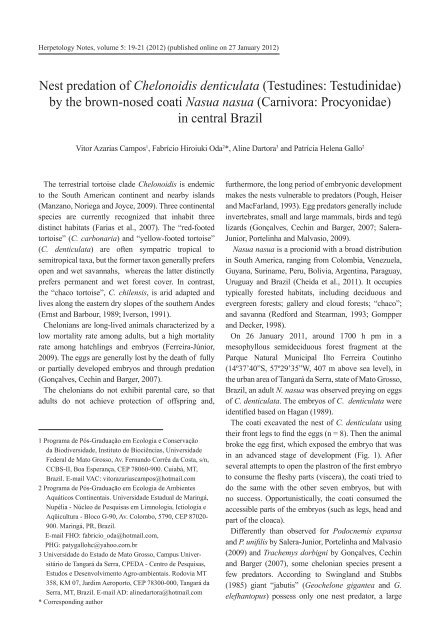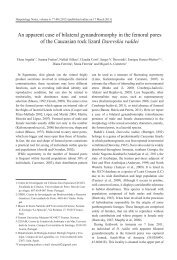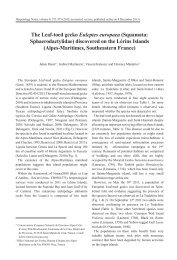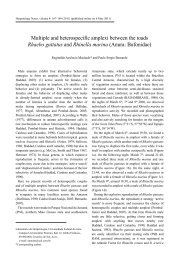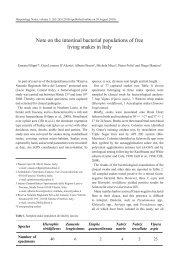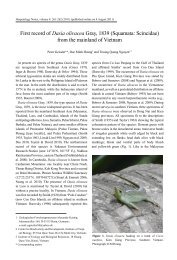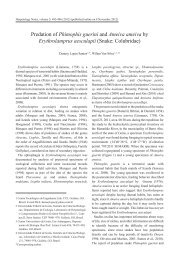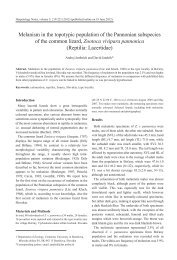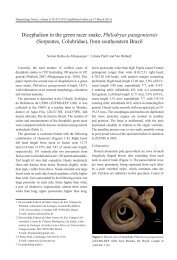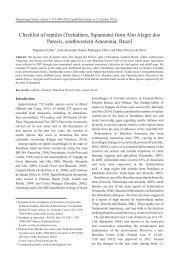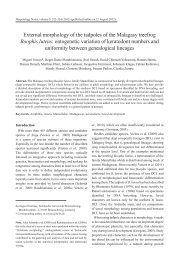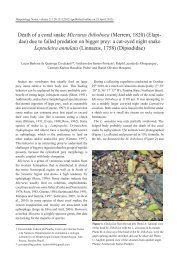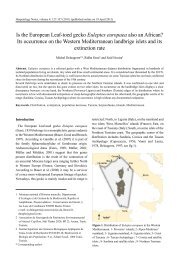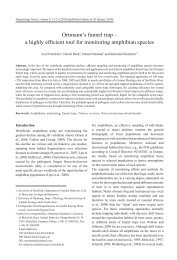Nest predation of Chelonoidis denticulata - Herpetology Notes
Nest predation of Chelonoidis denticulata - Herpetology Notes
Nest predation of Chelonoidis denticulata - Herpetology Notes
You also want an ePaper? Increase the reach of your titles
YUMPU automatically turns print PDFs into web optimized ePapers that Google loves.
<strong>Herpetology</strong> <strong>Notes</strong>, volume 5: 19-21 (2012) (published online on 27 January 2012)<br />
<strong>Nest</strong> <strong>predation</strong> <strong>of</strong> <strong>Chelonoidis</strong> <strong>denticulata</strong> (Testudines: Testudinidae)<br />
by the brown-nosed coati Nasua nasua (Carnivora: Procyonidae)<br />
in central Brazil<br />
Vitor Azarias Campos 1 , Fabrício Hiroiuki Oda 2 *, Aline Dartora 3 and Patrícia Helena Gallo 2<br />
The terrestrial tortoise clade <strong>Chelonoidis</strong> is endemic<br />
to the South American continent and nearby islands<br />
(Manzano, Noriega and Joyce, 2009). Three continental<br />
species are currently recognized that inhabit three<br />
distinct habitats (Farias et al., 2007). The “red-footed<br />
tortoise” (C. carbonaria) and “yellow-footed tortoise”<br />
(C. <strong>denticulata</strong>) are <strong>of</strong>ten sympatric tropical to<br />
semitropical taxa, but the former taxon generally prefers<br />
open and wet savannahs, whereas the latter distinctly<br />
prefers permanent and wet forest cover. In contrast,<br />
the “chaco tortoise”, C. chilensis, is arid adapted and<br />
lives along the eastern dry slopes <strong>of</strong> the southern Andes<br />
(Ernst and Barbour, 1989; Iverson, 1991).<br />
Chelonians are long-lived animals characterized by a<br />
low mortality rate among adults, but a high mortality<br />
rate among hatchlings and embryos (Ferreira-Júnior,<br />
2009). The eggs are generally lost by the death <strong>of</strong> fully<br />
or partially developed embryos and through <strong>predation</strong><br />
(Gonçalves, Cechin and Barger, 2007).<br />
The chelonians do not exhibit parental care, so that<br />
adults do not achieve protection <strong>of</strong> <strong>of</strong>fspring and,<br />
1 Programa de Pós-Graduação em Ecologia e Conservação<br />
da Biodiversidade, Instituto de Biociências, Universidade<br />
Federal de Mato Grosso, Av. Fernando Corrêa da Costa, s/n,<br />
CCBS-II, Boa Esperança, CEP 78060-900. Cuiabá, MT,<br />
Brazil. E-mail VAC: vitorazariascampos@hotmail.com<br />
2 Programa de Pós-Graduação em Ecologia de Ambientes<br />
Aquáticos Continentais. Universidade Estadual de Maringá,<br />
Nupélia - Núcleo de Pesquisas em Limnologia, Ictiologia e<br />
Aqüicultura - Bloco G-90, Av. Colombo, 5790, CEP 87020-<br />
900. Maringá, PR, Brazil.<br />
E-mail FHO: fabricio_oda@hotmail.com,<br />
PHG: patygallohc@yahoo.com.br<br />
3 Universidade do Estado de Mato Grosso, Campus Universitário<br />
de Tangará da Serra, CPEDA - Centro de Pesquisas,<br />
Estudos e Desenvolvimento Agro-ambientais. Rodovia MT<br />
358, KM 07, Jardim Aeroporto, CEP 78300-000, Tangará da<br />
Serra, MT, Brazil. E-mail AD: alinedartora@hotmail.com<br />
* Corresponding author<br />
furthermore, the long period <strong>of</strong> embryonic development<br />
makes the nests vulnerable to predators (Pough, Heiser<br />
and MacFarland, 1993). Egg predators generally include<br />
invertebrates, small and large mammals, birds and tegú<br />
lizards (Gonçalves, Cechin and Barger, 2007; Salera-<br />
Junior, Portelinha and Malvasio, 2009).<br />
Nasua nasua is a procionid with a broad distribution<br />
in South America, ranging from Colombia, Venezuela,<br />
Guyana, Suriname, Peru, Bolivia, Argentina, Paraguay,<br />
Uruguay and Brazil (Cheida et al., 2011). It occupies<br />
typically forested habitats, including deciduous and<br />
evergreen forests; gallery and cloud forests; “chaco”;<br />
and savanna (Redford and Stearman, 1993; Gompper<br />
and Decker, 1998).<br />
On 26 January 2011, around 1700 h pm in a<br />
mesophyllous semideciduous forest fragment at the<br />
Parque Natural Municipal Ilto Ferreira Coutinho<br />
(14º37’40”S, 57º29’35”W, 407 m above sea level), in<br />
the urban area <strong>of</strong> Tangará da Serra, state <strong>of</strong> Mato Grosso,<br />
Brazil, an adult N. nasua was observed preying on eggs<br />
<strong>of</strong> C. <strong>denticulata</strong>. The embryos <strong>of</strong> C. <strong>denticulata</strong> were<br />
identified based on Hagan (1989).<br />
The coati excavated the nest <strong>of</strong> C. <strong>denticulata</strong> using<br />
their front legs to find the eggs (n = 8). Then the animal<br />
broke the egg first, which exposed the embryo that was<br />
in an advanced stage <strong>of</strong> development (Fig. 1). After<br />
several attempts to open the plastron <strong>of</strong> the first embryo<br />
to consume the fleshy parts (viscera), the coati tried to<br />
do the same with the other seven embryos, but with<br />
no success. Opportunistically, the coati consumed the<br />
accessible parts <strong>of</strong> the embryos (such as legs, head and<br />
part <strong>of</strong> the cloaca).<br />
Differently than observed for Podocnemis expansa<br />
and P. unifilis by Salera-Junior, Portelinha and Malvasio<br />
(2009) and Trachemys dorbigni by Gonçalves, Cechin<br />
and Barger (2007), some chelonian species present a<br />
few predators. According to Swingland and Stubbs<br />
(1985) giant “jabutis” (Geochelone gigantea and G.<br />
elefhantopus) possess only one nest predator, a large
20<br />
land crab (Birgus latro). However, records <strong>of</strong> <strong>predation</strong><br />
on C. <strong>denticulata</strong> nests are unknown in literature.<br />
Coatis are diurnal, scansorial and omnivore, feeding<br />
mainly on invertebrates, fruits, and occasional vertebrate<br />
prey (Redford and Stearman, 1993; Gompper and<br />
Decker, 1998; Peracchi, Rocha and Reis, 2002; Alves-<br />
Costa, Fonseca and Christófaro, 2004; Hirsch, 2009;<br />
Rocha-Mendes et al., 2010). Additionally, opportunistic<br />
feeding on frogs, dead birds and turtle eggs buried in the<br />
ground (undetermined species) has also been observed<br />
(Hirsch, 2009). Here we report the first record <strong>of</strong> a N.<br />
nasua as a potential predator <strong>of</strong> nests <strong>of</strong> the “jabuti”, C.<br />
<strong>denticulata</strong>.<br />
The present study demonstrates that nests <strong>of</strong> C.<br />
<strong>denticulata</strong> are subject to <strong>predation</strong> by generalist species<br />
such as N. nasua, which contributes to the mortality <strong>of</strong><br />
nests. In this context, it is important to emphasize the<br />
necessity <strong>of</strong> future studies, which are fundamental to<br />
the understanding <strong>of</strong> the impact <strong>of</strong> highly predatory<br />
behavior <strong>of</strong> coatis on chelonians nests.<br />
Vitor Azarias Campos et al.<br />
Figure 1. Nasua nasua preying on eggs <strong>of</strong> <strong>Chelonoidis</strong> <strong>denticulata</strong> in a mesophyllous semideciduous forest fragment at the Parque<br />
Natural Municipal Ilto Ferreira Coutinho, municipality <strong>of</strong> Tangará da Serra, state <strong>of</strong> Mato Grosso, Brazil.<br />
Acknowledgements. We thank Fernando I. Martins, Paulo S.<br />
Bernarde, Mariana F. Felismino, Tiago S. Vasconcelos and one<br />
anonymous reviewer for comments on this manuscript. Amanda<br />
B. Campos and Ketlin Dartore for field assistance. The Conselho<br />
Nacional de Desenvolvimento Científico e Tecnológico (CNPq)<br />
provided financial support to V.A. Campos and P.H. Gallo, and<br />
Coordenação de Aperfeiçoamento de Pessoal de Nível Superior<br />
(CAPES) provided financial support to F.H. Oda.<br />
References<br />
Alves-Costa, C.P., Fonseca, G.A.B., Christófaro, C. (2004): Variation<br />
in the diet <strong>of</strong> the brown-nosed coati (Nasua nasua) in<br />
southeastern Brazil. J. Mamm. 85: 478-482.<br />
Cheida, C.C., Nakano-Oliveira, E., Fusco-Costa, R., Rocha-Mendes,<br />
F. and Quadros, J. (2011): Ordem Carnívora. In: Mamíferos<br />
do Brasil, p. 269-271, Reis, N.R., Peracchi, A.L., Pedro,<br />
W.A., Lima, I.P., Eds., 2ª Edição, Londrina.<br />
Ernst, C.H. and Barbour, R.W. (1989): Turtles <strong>of</strong> the World.<br />
Smithsonian Institution Press, Washington, D.C.<br />
Farias, I.P., Jerozolimski, A., Melo, A., Viana, M.N., Martins, M.,<br />
Monjeló, L.A.S. (2007): Population genetics <strong>of</strong> the Amazonian
<strong>Nest</strong> <strong>predation</strong> <strong>of</strong> <strong>Chelonoidis</strong> <strong>denticulata</strong> 21<br />
tortoises, <strong>Chelonoidis</strong> <strong>denticulata</strong> and C. carbonaria, (Cryptodira:<br />
Testudinidae) in an area <strong>of</strong> sympatry. Amphibia-Reptilia<br />
28: 357-365.<br />
Ferreira-Jr, P.D. (2009): Efeitos de fatores ambientais na reprodução<br />
de tartarugas. Acta Amazonica 39: 319-334.<br />
Gompper, M.E., Decker, D.M. (1998): Nasua nasua. Mamm.<br />
Spec. 580: 1-9.<br />
Gonçalves, F.A., Cechin, S.Z. and Bager, A. (2007): Predação de<br />
ninhos de Trachemys dorbigni (Duméril & Bibron) (Testudines,<br />
Emydidae) no extremo sul do Brasil. Rev. Bras. Zool. 24:<br />
1063-1070.<br />
Hagan, J.W. (1989): What’s the difference - Differentiating Geochelone<br />
<strong>denticulata</strong> and Geochelone carbonaria. Tortuga Gazette<br />
25: 3-4<br />
Hirsch, B.T. (2009): Seasonal variation in the diet <strong>of</strong> ring-tailed<br />
coatis (Nasua nasua) in Iguazu, Argentina. J. Mamm. 90: 136-<br />
143.<br />
Iverson, J.B. (1991): Patterns <strong>of</strong> survivorship in turtles (order Testudines).<br />
Can. J. Zool. 69: 385-391.<br />
Le, M., Raxworthy, C.J., McCord, W.P., Mertz, L. (2006): A<br />
molecular phylogeny <strong>of</strong> tortoises (Testudines: Testudinidae)<br />
based on mitochondrial and nuclear genes. Mol. Phylogenet.<br />
Evol. 40: 517-531.<br />
Manzano, A.S., Noriega, J.I., Joyce, W.G. (2009): The tropical<br />
tortoise <strong>Chelonoidis</strong> <strong>denticulata</strong> (Testudines: Testudinidae)<br />
from the Late Pleistocene <strong>of</strong> Argentina and its paleoclimatological<br />
implications. J. Paleont. 83: 975-980.<br />
Peracchi, A.L., Rocha, V.J., Reis, N.R. (2002): Mamíferos nãovoadores<br />
da bacia do rio Tibagi. In: A bacia do rio Tibagi, p.<br />
225-249, Medri, M.E., Bianchini, E., Shibatta, O.A., Pimenta,<br />
J.A., Eds, Londrina, PR.<br />
Pough, F.H., Heiser, J.B., McFarland, W.N. (1993): A Vida dos<br />
Vertebrados, Atheneu Editora. São Paulo (SP), 839 pp.<br />
Redford, K.H., Stearman, A.M.L. (1993): Notas sobre la biologia<br />
de tres procionidos simpatricos bolivianos (Mammalia,<br />
Procyonidae). Ecol. Boliv. 21: 35-44.<br />
Rocha-Mendes, F., Mikich, S.B., Quadros, J., Pedro, W.A. (2010):<br />
Ecologia alimentar de carnívoros (Mammalia, Carnivora) em<br />
fragmentos de Floresta Atlântica do Sul do Brasil. Biota Neotr.<br />
10: 21-30.<br />
Salera-Jr., G., Portelinha, T.C.G., Malvasio, A. (2009): Predação<br />
de fêmeas adultas de Podocnemis expansa Schweigger<br />
(Testudines, Podocnemididae) por Panthera onca Linnaeus<br />
(Carnivora, Felidae), no Estado do Tocantins. Biota Neotr. 9:<br />
387-391.<br />
Swingland, I.R., Stubbs, D. (1985): The ecology <strong>of</strong> mediterranean<br />
tortoise (Testudo hermanii): Reprodution. J. Zool. 205:<br />
595-610.<br />
Accepted by Philip de Pous


